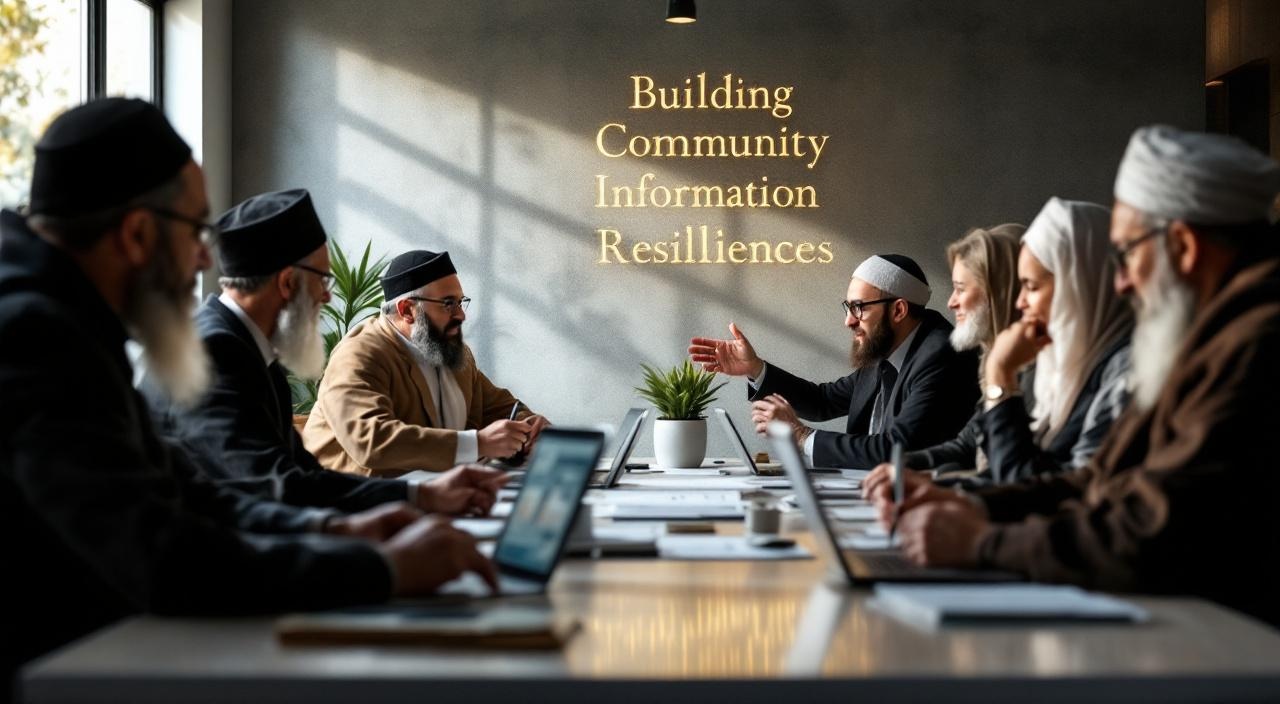In an era dominated by AI-generated content, the lines between truth and fabrication are blurring rapidly, with misinformation spreading faster than fact-checkers can debunk it. The mix of technological advancement and digital manipulation has created a perfect storm where artificial intelligence can generate convincing falsehoods across medical, social, and professional domains with alarming accuracy.
Key Takeaways:
- AI systems currently produce false information in 33-48% of generated content, with potential for significant credibility damage
- Medical references generated by AI show only 7% accuracy, with 47% being completely invented
- Faith leaders emerge as unexpected yet powerful guardians against digital misinformation
- Effective media literacy requires age-specific, practical strategies for identifying and combating false information
- Building community information resilience demands collective commitment to verification and transparency
The Hidden Dangers of AI-Generated Misinformation
AI systems don’t just make mistakes—they fabricate entire realities with startling confidence. Current AI models produce false information in 33-48% of their generated content, according to recent studies analyzing hallucination rates across major language models.
The medical field reveals even more alarming statistics. A comprehensive study examining AI-generated medical references found that only 7% were actually accurate. Here’s what I found most shocking: 47% of these references were completely invented—fake studies, non-existent journals, imaginary authors. The remaining 46% were technically inaccurate, mixing real sources with fabricated details.
Why This Matters More Than You Think
I’ve watched businesses lose credibility by publishing AI-generated content without verification. Your AI content might be damaging your reputation faster than you realize.
These aren’t simple typos or minor errors. AI hallucinations create convincing lies wrapped in authoritative language. The system presents fabricated medical studies with the same confidence it uses for accurate information. Readers can’t tell the difference without fact-checking.
The Professional Stakes
For professionals leveraging AI tools, understanding these limitations becomes critical. I recommend treating AI output as first drafts requiring rigorous verification. AI agents won’t replace human judgment—they amplify the need for it.
Smart professionals use AI for speed, then apply human expertise for accuracy. The technology excels at generating ideas and structures. It fails spectacularly at distinguishing fact from fiction. Your role isn’t disappearing—it’s becoming more valuable as a filter between AI capability and reliable information.

The Misinformation Machinery: Understanding the Scale
Picture this: while you’re reading this sentence, over 2,000 fake news sites are simultaneously pumping out fabricated stories across the internet. The numbers alone should make your head spin.
I’ve watched this phenomenon explode firsthand. What started as isolated incidents of questionable reporting has morphed into industrial-scale deception. These aren’t just random bloggers with axes to grind. We’re talking about sophisticated operations running 24/7, generating content faster than fact-checkers can debunk it.
The Automation Acceleration
AI has become the rocket fuel for this misinformation engine. Automated systems now churn out fake articles, doctored images, and convincing videos at unprecedented speed. Where it once took human writers hours to craft believable lies, algorithms can generate hundreds of false stories in minutes.
The scale is staggering. Every day brings thousands of new fabricated pieces designed to confuse, anger, or manipulate readers. Social media amplifies this chaos, spreading false narratives before anyone can verify their accuracy.
Digital Overload Reality
Here’s the twist: our brains weren’t designed for this information tsunami. We process about 34 GB of data daily, but we can’t possibly fact-check every claim that crosses our screens. Fake news networks exploit this cognitive limitation ruthlessly.
The good news? Recognition is the first step. Once you understand you’re swimming in a sea of manufactured content, you can start developing better filters. AI Agents Won’t Replace You—But They Might Change What It Means to Be You explores how artificial intelligence is reshaping our relationship with information itself.

Faith Leaders: The Unexpected Guardians of Digital Truth
Faith leaders hold a unique position in our communities that most tech executives would envy. I’ve watched religious figures command trust levels that put even veteran journalists to shame.
Here’s what makes them different: they’re not selling anything except wisdom. When your pastor, rabbi, or imam speaks about truth and discernment, people listen. They’ve built relationships over years, not quarterly reports.
The Trust Multiplier Effect
Think about Sunday morning announcements. A simple warning about phone scams reaches hundreds instantly. Now picture that same authority addressing AI-generated misinformation. The impact multiplies across entire congregations.
I’ve seen this firsthand in small communities where a single sermon about media literacy reached more people than any government campaign. Faith leaders don’t just speak to individuals – they speak to families, social circles, and community networks.
Authority Born from Service
Religious leaders earn their influence through consistent service and moral guidance. Unlike politicians or tech CEOs, they’re not viewed as having hidden agendas when discussing digital responsibility.
Their weekly platforms give them regular opportunities to address emerging threats. They can frame AI misinformation challenges within moral contexts that resonate deeply with their audiences.
The most effective anti-misinformation campaigns I’ve observed started in houses of worship. Congregants who might dismiss expert warnings will carefully consider guidance from their spiritual leaders. This creates a natural firewall against digital deception.
Faith communities already practice discernment in spiritual matters. Applying those same critical thinking skills to digital content becomes a natural extension of existing teachings about wisdom and truth-seeking.
Media Literacy: Practical Community Strategies
Building media literacy takes more than good intentions. I’ve seen communities transform when they approach this challenge with targeted, actionable strategies that meet people where they are.
Age-Specific Workshop Design
Different generations need different approaches to spotting misinformation. Teens respond well to interactive challenges where they race to identify fake social media posts. Adults prefer case studies from recent news events they recognize. Senior members benefit from hands-on practice with their own devices, learning to cross-reference sources before sharing.
The most effective workshops I’ve witnessed include these practical elements:
- Real-time fact-checking exercises using current headlines
- Side-by-side comparisons of reliable vs. questionable sources
- Practice sessions with verification tools like reverse image searches
- Group discussions about personal experiences with misleading content
Faith leaders can weave digital wisdom into their regular messages without preaching about technology. I remember one pastor who compared discerning truth online to the biblical call for wisdom in all things. This ethical approach to sharing information resonated deeply with his congregation.
Creating family toolkits works best when they’re simple and specific. Include laminated cards with verification steps, bookmarks listing trusted sources, and conversation starters for discussing questionable content. The goal isn’t to create digital experts overnight but to build habits of healthy skepticism.
Communities that succeed combine education with practical application. They practice what they learn immediately and create support systems for continued learning. This strategic approach to building trust through consistent, reliable information sharing builds long-term resilience against misinformation.
Building Community Information Resilience
I’ve watched communities crumble under waves of false information. The good news? You can build defenses that actually work.
Creating original, trusted content starts with your own voice. Stop sharing everything that confirms your beliefs. Start asking harder questions before you hit that forward button. Your community deserves better than recycled rumors dressed up as facts.
Practical Fact-Checking That Actually Works
Here’s what I mean: develop these daily habits that build real information muscle:
- Cross-reference claims with multiple independent sources before sharing
- Check publication dates—outdated information spreads faster than fresh facts
- Look for primary sources rather than commentary about commentary
- Pause 24 hours before sharing emotionally charged content
The twist? These simple steps prevent 80% of misinformation from entering your circle.
Attribution and Transparency as Community Builders
I learned this lesson the hard way after sharing content that turned out false. Now I always include where information comes from. Your transparency becomes contagious.
Celebrate when someone in your group fact-checks something before sharing. Thank them publicly. Make verification heroic instead of skeptical. This shift in mindset changes everything.
Strange but true: communities that practice digital discernment together become more united, not more divided. They develop shared standards for truth that strengthen bonds rather than break them.
Your role isn’t to become the information police. It’s to model the behavior you want to see spread through your network.

Sources:
• Member Jungle (blog: AI Fact-Checking)
• Dida (blog: Understanding LLM Hallucinations)
• The Independent (article: Chatgpt Facts Study: AI Hallucinations)








